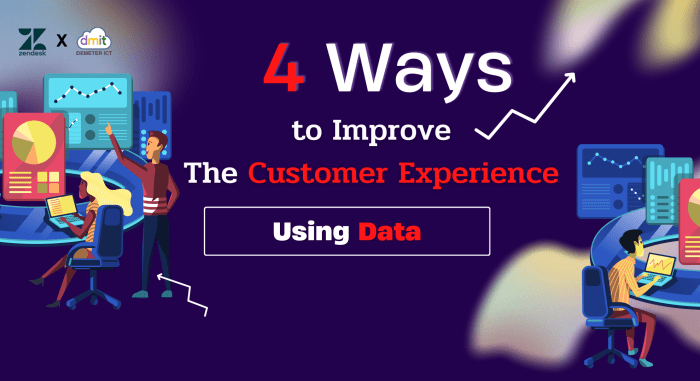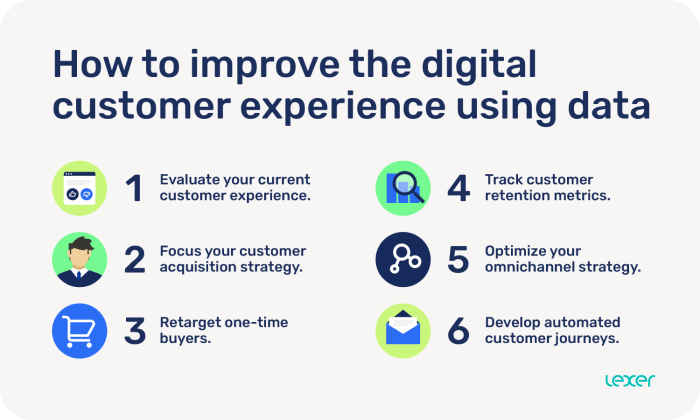Using Data to Improve Customer Experience sets the stage for businesses to revolutionize their customer interactions through strategic data analysis, paving the way for unparalleled growth and satisfaction.
In today’s competitive market, understanding the importance of leveraging data for enhancing customer experience is crucial for businesses striving to stay ahead of the curve.
Importance of Using Data to Improve Customer Experience
In today’s competitive business landscape, leveraging data to enhance customer experience has become crucial for companies looking to stay ahead of the curve. By analyzing customer data effectively, businesses can gain valuable insights into customer behavior and preferences, ultimately leading to improved customer satisfaction and loyalty.
Understanding Customer Behavior through Data Analytics
Data analytics plays a key role in helping businesses understand their customers better. By analyzing data from various sources such as customer interactions, purchasing patterns, and feedback, companies can identify trends and patterns that provide valuable insights into what customers want and need. This understanding allows businesses to tailor their products and services to meet customer expectations, ultimately leading to a more personalized and engaging customer experience.
Examples of Companies Utilizing Data to Improve Customer Satisfaction
– Amazon: Amazon uses customer data to personalize product recommendations, improve search results, and enhance the overall shopping experience. By analyzing customer behavior, Amazon can predict what customers are likely to buy next and tailor their recommendations accordingly.
– Netflix: Netflix leverages data to recommend personalized content to its users based on their viewing history and preferences. By analyzing viewing habits and ratings, Netflix can suggest movies and TV shows that are likely to resonate with each individual user, leading to higher customer satisfaction and engagement.
– Starbucks: Starbucks uses customer data to personalize marketing campaigns, offer targeted promotions, and improve the overall customer experience. By analyzing customer purchase history and preferences, Starbucks can create personalized offers and rewards that keep customers coming back for more.
By utilizing data effectively, companies can not only improve customer satisfaction but also drive business growth and stay ahead of the competition in today’s digital age.
Collecting Relevant Data for Customer Experience Enhancement: Using Data To Improve Customer Experience
In order to enhance customer experience, it is crucial to collect relevant data from various sources and effectively organize it for analysis. By understanding the different sources of data and key data points, businesses can improve customer interactions and satisfaction.
Different Sources of Valuable Data, Using Data to Improve Customer Experience
- Customer feedback: Surveys, reviews, and direct feedback can provide insights into customer preferences and pain points.
- Website analytics: Tracking website traffic, user behavior, and conversion rates can help identify areas for improvement.
- Social media monitoring: Monitoring social media platforms for mentions, comments, and reviews can offer real-time feedback on customer sentiment.
Collecting and Organizing Customer Data Effectively
- Implement a customer relationship management (CRM) system to centralize customer data and interactions.
- Utilize data analytics tools to process and analyze large volumes of customer data efficiently.
- Ensure data privacy and compliance with regulations when collecting and storing customer information.
Examples of Crucial Data Points for Analysis
- Purchase history: Understanding past purchases can help personalize recommendations and promotions.
- Customer demographics: Knowing age, location, and other demographic information can tailor marketing efforts to specific customer segments.
- Customer satisfaction scores: Tracking customer satisfaction levels can pinpoint areas for improvement in products or services.
Analyzing Data to Identify Customer Needs and Preferences

Analyzing data to identify customer needs and preferences is crucial for businesses to enhance customer experience and drive satisfaction. By leveraging data analytics, businesses can gain valuable insights into customer behavior, allowing them to tailor their products and services to meet specific needs and preferences.
Segmenting Customers Based on Preferences and Needs
Segmenting customers based on their preferences and needs is essential for delivering personalized experiences. By categorizing customers into different segments, businesses can create targeted marketing campaigns, offer relevant product recommendations, and provide tailored customer support. This approach helps businesses better understand their customers and build stronger relationships with them.
- Segmenting customers based on demographics, psychographics, and behavior patterns allows businesses to target specific customer groups with personalized messaging and offerings.
- By analyzing data on past purchases, browsing behavior, and feedback, businesses can identify trends and patterns in customer preferences, enabling them to anticipate future needs and tailor their offerings accordingly.
- Utilizing customer feedback and sentiment analysis can help businesses understand customer satisfaction levels and sentiment towards their brand, allowing them to address any issues or concerns proactively.
Implementing Data-Driven Strategies for Customer Engagement

In today’s digital age, businesses have a wealth of customer data at their fingertips. By leveraging this data effectively, companies can implement data-driven strategies to enhance customer engagement and drive business growth.
Using Data for Targeted Marketing Campaigns
Data insights play a crucial role in creating targeted marketing campaigns that resonate with customers on a personal level. By analyzing customer behavior, preferences, and purchase history, businesses can tailor their marketing messages to specific customer segments. For example, e-commerce giant Amazon uses data to recommend products based on past purchases and browsing history, leading to increased sales and customer satisfaction.
Improving Customer Communication and Engagement
Data can also be utilized to improve customer communication and engagement. By tracking customer interactions across various touchpoints, businesses can gain valuable insights into customer preferences and pain points. This information can then be used to personalize communication with customers, provide relevant offers, and address any issues promptly. For instance, airline companies like Delta use data to send personalized flight updates and notifications, enhancing the overall customer experience.
Successful Strategies Using Data-Driven Approaches
Several companies have successfully implemented data-driven strategies to improve customer engagement. For instance, Starbucks uses customer data to offer personalized recommendations through its mobile app, driving customer loyalty and repeat purchases. Similarly, Netflix leverages data to deliver customized content recommendations to users, leading to higher user engagement and retention rates.





